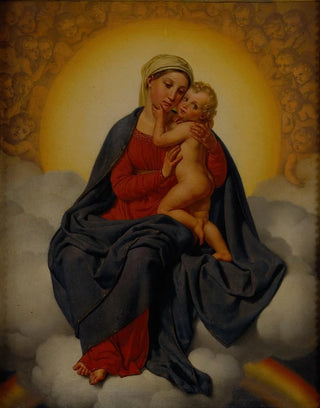Art print The Virgin and Child - Christoffer Wilhelm Eckersberg | Art print


View from behind

Frame (optional)
Christoffer Wilhelm Eckersberg’s iconic painting, The Virgin and Child, stands out for its emotional depth and aesthetic refinement. This artwork, which evokes tenderness and piety, transports viewers into a universe where spirituality meets beauty. Eckersberg, often regarded as the father of Danish realism, masterfully captures moments of grace with such intensity that one can almost feel the warmth of the bonds uniting mother and child. The depiction of the Virgin, surrounded by a soft, enveloping light, invites serene contemplation, encouraging each viewer to reflect on the nature of motherhood and faith.
Style and uniqueness of the work
Eckersberg’s style is characterized by meticulous attention to detail and mastery of light effects. In The Virgin and Child, the delicacy of the features and the richness of colors create an atmosphere imbued with gentleness and peace. The composition is carefully balanced, with each element arranged to guide the viewer’s gaze toward the serene face of the Virgin and the innocent gaze of the Child. The drapery, rendered with remarkable precision, adds a tactile dimension to the piece, while the expressions of the characters convey palpable emotion. Eckersberg succeeds in blending tradition and modernity, reinterpreting classical themes with an innovative perspective, which gives his work a unique place in art history.
The artist and his influence
Christoffer Wilhelm Eckersberg, born in 1783, left a lasting mark on the 19th century through his innovative approach and commitment to artistic truth. Trained at the Royal Danish Academy of Fine Arts in Copenhagen, he was influenced by European masters while developing a style that was uniquely his own. His work paved the way for many Danish artists, establishing a link between Romanticism and realism. Through his paintings, he not only explored religious themes but also offered a critical view of his society. His influence endures, inspiring generations of artists seeking to capture the essence of humanity through painting.

Matte finish

View from behind

Frame (optional)
Christoffer Wilhelm Eckersberg’s iconic painting, The Virgin and Child, stands out for its emotional depth and aesthetic refinement. This artwork, which evokes tenderness and piety, transports viewers into a universe where spirituality meets beauty. Eckersberg, often regarded as the father of Danish realism, masterfully captures moments of grace with such intensity that one can almost feel the warmth of the bonds uniting mother and child. The depiction of the Virgin, surrounded by a soft, enveloping light, invites serene contemplation, encouraging each viewer to reflect on the nature of motherhood and faith.
Style and uniqueness of the work
Eckersberg’s style is characterized by meticulous attention to detail and mastery of light effects. In The Virgin and Child, the delicacy of the features and the richness of colors create an atmosphere imbued with gentleness and peace. The composition is carefully balanced, with each element arranged to guide the viewer’s gaze toward the serene face of the Virgin and the innocent gaze of the Child. The drapery, rendered with remarkable precision, adds a tactile dimension to the piece, while the expressions of the characters convey palpable emotion. Eckersberg succeeds in blending tradition and modernity, reinterpreting classical themes with an innovative perspective, which gives his work a unique place in art history.
The artist and his influence
Christoffer Wilhelm Eckersberg, born in 1783, left a lasting mark on the 19th century through his innovative approach and commitment to artistic truth. Trained at the Royal Danish Academy of Fine Arts in Copenhagen, he was influenced by European masters while developing a style that was uniquely his own. His work paved the way for many Danish artists, establishing a link between Romanticism and realism. Through his paintings, he not only explored religious themes but also offered a critical view of his society. His influence endures, inspiring generations of artists seeking to capture the essence of humanity through painting.
12,34 €






